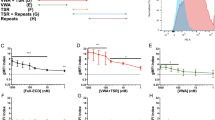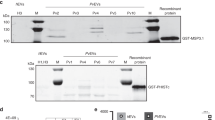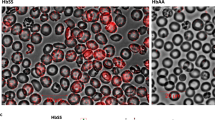Abstract
Plasmodium falciparum infected erythrocytes containing mature trophozoites and schizonts sequester along venular endothelium1 and are not in the peripheral circulation of patients with malaria. Knobs appear on infected erythrocytes and are the points of attachment to endothelium2. Sequestration may protect the parasite from splenic destruction3 and may play a role in the pathogenesis of cerebral malaria4. Correlates of sequestration have been developed in vitro using cultured human endothelium5 and an amelanotic melanoma cell line6. Knobless strains (K−) of P. falciparum fail to sequester in vivo and to bind to cells in vitro. We now present evidence that the receptor for cytoadherence is the glycoprotein, thrombospondin. Aotus monkey or human erythrocytes containing knobby (K+) but not Aotus erythrocytes containing knobless strains of P. falciparum bind to immobilized thrombospondin. Neither binds to the adhesive proteins laminin, fibronectin, factor VIII/von Wi lie brand factor or vitronectin. Both soluble thrombospondin and anti-thrombospondin antibodies inhibit binding of parasitized Aotus erythrocytes to immobilize thrombospondin and to melanoma cells which secrete thrombospondin.
This is a preview of subscription content, access via your institution
Access options
Subscribe to this journal
Receive 51 print issues and online access
$199.00 per year
only $3.90 per issue
Buy this article
- Purchase on Springer Link
- Instant access to full article PDF
Prices may be subject to local taxes which are calculated during checkout
Similar content being viewed by others
References
Miller, L. H. Am. J. trop. Med. Hyg. 18, 860–865 (1969).
Luse, S. A. & Miller, L. H. Am. J. trop. Med. Hyg. 20, 655–660 (1971).
Barnwell, J. W., Howard, R. J. & Miller, L. H. Ciba Fdn Symp. 94, 117–136 (1983).
Edington, G. M. Ann. trop. Med. Parasit. 48, 300–306 (1954).
Udeinya, I. J., Schmidt, J. A., Aikawa, M., Miller, L. H. & Green, I. Science 213, 555–557 (1981).
Schmidt, J. A. et al. J. clin. Invest. 70, 379–396 (1982).
Baenziger, N. L., Brodie, G. N. & Majerus, P. W. Proc. natn. Acad. Sci. U.S.A. 68, 240–243 (1971).
Phillips, D. R., Jennings, L. K. & Prasanna, H. R. J. biol. Chem. 255, 11629–11632 (1980).
Yamada, K. M. A. Rev. Biochem. 52, 761–799 (1983).
Timpl, R. et al. J. biol Chem. 254, 9933–9937 (1979).
Hayman, E. G., Pierschbacher, M. D., Ohgren, Y. & Ruoslahti, E. Proc. natn. Acad. Sci. U.S.A. 80, 4003–4007 (1983).
Hoyer, L. W., de los Santos, R. & Hoyer, J. R. J. clin. Invest. 52, 2737–2744 (1973).
Udeinya, I. J., Graves, P. M., Carter, R., Aikawa, M. & Miller, L. H. Expl Parasit. 56, 207–214 (1983).
Dixit, V. M. et al. Proc. natn. Acad. Sci. U.S.A. 82, 3472–3476 (1985).
Roberts, D. D. et al. J. biol. Chem. 260, 9405–9411 (1985).
Mosher, D. F., Doyle, M. J. & Jaffe, E. A. J. Cell Biol. 93, 343–348 (1982).
Raugi, G. J., Mumby, S. M., Abbott-Brown, D. & Bornstein, P. J. Cell Biol. 95, 351–354 (1982).
Leech, J. H., Barnwell, J. W., Miller, L. H. & Howard, R. J. J. exp. Med. 159, 1567–1575 (1984).
Aley, S. B., Sherwood, J. A. & Howard, R. J. J. exp. Med. 160, 1585–1590 (1984).
Haverstick, D. M., Dixit, V. M., Grant, G. A., Frazier, W. A. & Santoro, S. A. Biochemistry 23, 5597–5603 (1984).
David, P. H., Hommel, M., Miller, L. H., Udeinya, I. J. & Oligino, L. D. Proc. natn. Acad. Sci. U.S.A. 80, 5075–5079 (1983).
Degowin, R. L. & Powell, R. D. Am. J. trop. Med. Hyg. 14, 519–528 (1965).
Collins, W. E., Warren, M., Skinner, J. C., Chin, W. & Richardson, B. B. J. Parasit., 52–56 (1977).
Graves, P. M., Carter, R., Keystone, J. S. & Seeley, D. C. Jr Am. J. trop. Med. Hyg. 33, 212–219 (1984).
Trager, W. & Jensen, J. B. Science 193, 673–675 (1976).
Geiman, Q. M. & Meagher, M. J. Nature 215, 437–439 (1967).
Barnwell, J. W., Howard, R. J., Coon, H. G. & Miller, L. H. Infect. Immun. 40, 985–994 (1983).
Haynes, J. D., Diggs, C. L., Hines, F. A. & Desjardins, R. E. Nature 263, 767–769 (1976).
Sodetz, J. M., Pizzo, S. V. & McKee, P. A. J. biol Chem. 252, 5538–5546 (1977).
Grinnell, F. & Feld, M. K. J. biol. Chem. 257, 4888–4893 (1982).
Author information
Authors and Affiliations
Rights and permissions
About this article
Cite this article
Roberts, D., Sherwood, J., Spitalnik, S. et al. Thrombospondin binds falciparum malaria parasitized erythrocytes and may mediate cytoadherence. Nature 318, 64–66 (1985). https://doi.org/10.1038/318064a0
Received:
Accepted:
Published:
Issue Date:
DOI: https://doi.org/10.1038/318064a0
This article is cited by
-
Age-dependent increase in antibodies that inhibit Plasmodium falciparum adhesion to a subset of endothelial receptors
Malaria Journal (2019)
-
Host factors that modify Plasmodium falciparum adhesion to endothelial receptors
Scientific Reports (2017)
-
Surface antigens of Plasmodium falciparum-infected erythrocytes as immune targets and malaria vaccine candidates
Cellular and Molecular Life Sciences (2014)
-
Identification of glycosaminoglycan binding regions in the Plasmodium falciparum encoded placental sequestration ligand, VAR2CSA
Malaria Journal (2008)
-
Changes in var gene mRNA levels during erythrocytic development in two phenotypically distinct Plasmodium falciparum parasites
Malaria Journal (2007)
Comments
By submitting a comment you agree to abide by our Terms and Community Guidelines. If you find something abusive or that does not comply with our terms or guidelines please flag it as inappropriate.



